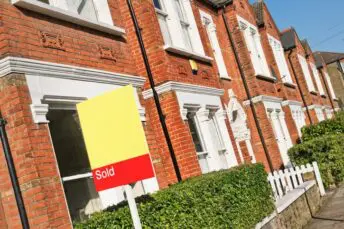House Price Watch Aug 2022
House prices remain firm in spite of growing economic uncertainty. However, there are signs the housing market is losing some momentum with softening buyer demand and declining mortgage activity for house purchases. Given increases in the cost of living and higher mortgage rates, we expect buyer demand to continue to fall in the months ahead. In the near term, house prices will remain underpinned by a shortage of homes for sale, though the rate of price growth is likely to slow in the last quarter of the year.
What’s happening nationally
House prices are up on average +1.1% in the past month and +12.3% in the past year.
While the average monthly and annual house price indices continue to show a rise in house prices, it is important to look at individual indices to see emerging trends. Rightmove is starting to show a fall in asking prices in August and both Nationwide and Halifax, tracking mortgage applications for house purchase in August show a slowing of annual house price growth. Land Registry, reporting July figures reports significantly higher growth rates and is pushing up the overall average.
Indices based on:
Land Registry – registered property transactions in July.
Nationwide & Halifax – mortgage valuations in August.
Rightmove – asking prices posted on Rightmove in August.
*Rightmove is not included in the index average as the basis for its index is different (asking price vs agreed sale price)
| Index reports: | Monthly change | Annual change |
|---|---|---|
| Land registry | +2.0% | +15.5% |
| Nationwide | +0.8% | +10.0% |
| Halifax | +0.4% | +11.5% |
| Rightmove | -1.3% | +8.2% |
| Average change | +1.1% | +12.3% |
House prices in your area
All regions of the UK have seen house prices up over the past month and many areas have experienced astronomical growth over the past year.
Areas with growth well into double digits include: the South West (+20.7%), North West (+18.1%), West Midlands (18.0%), Yorkshire & Humber (17.7%) and Wales (17.6%).
Average house prices are highest in London (£544K) and lowest in the North East (£163K).
House price growth varies somewhat by property type. Detached homes have seen the biggest rise (+17.3%) and flats/ maisonettes the smallest (+9.3%) according to Land Registry data. This may reflect regional price differences (more flats in London), as well as, demand – higher demand for bigger properties and fewer properties of this type available for sale over the past year.
| UK Region | Average price £ | Monthly change | Annual change |
|---|---|---|---|
| England | |||
| Nothern Ireland | |||
| Scotland | |||
| Wales | |||
| North West | |||
| Yorkshire and The Humber | |||
| North East | |||
| West Midlands | |||
| East Midlands | |||
| South West | |||
| East of England | |||
| South East | |||
| London |
| UK City | Average price | Annual change |
|---|---|---|
Market Monitor
Transactions increased in July and are slightly higher than usual for this time of year.
There were 104K transactions in July up 3% on June 2022 and up 37% on July last year (note July 2021 transactions particularly low because of bumper transactions in June 2021 coinciding with end of stamp duty holiday).
Demand continues to soften. Stock of homes for sale improves slightly.
Time to sell slightly slower but still above the 12 month average.
How busy is the market?
- Not busy
- Normal
- Very busy
- Transactions up month on month and slightly higher than is typical this time of year.
- Total transactions in July 104K
- +3.0% from last month
- +37% from July last year (unusually high transactions in June 2021 with stamp duty holiday)
Homes for sale vs homebuyers
- Good availability of homes
- Normal
- Shortage of homes
- Buyer enquiries continue to soften (-4% Rightmove); but still 20% above 2019 levels
- Seller enquiries up on same period last year (+12% Rightmove)
- Average stock per agent 47; improving (incl under offer/ Sold STC Rightmove)
Average speed of sale
- Fast
- Normal
- Slow
- 33 days to find a buyer (12 month average 36 days Rightmove)
What the experts say
Rightmove

“A drop in asking prices is to be expected this month, as the market returns towards normal seasonal patterns after a frenzied two years, and many would-be home movers become distracted by the summer holidays. Indeed, for those that can, this may be their first summer holiday abroad since before the pandemic. Sellers who want or need to move quickly at this time of year tend to price competitively in order to find a suitable buyer fast, with some hoping to complete their move in time to enjoy Christmas in a new home. We’re still expecting price changes for the rest of the year to continue to follow the usual seasonal pattern.”
Nationwide

“While annual house price growth softened in August, it remained in double digits for the tenth month in a row. There are signs that the housing market is losing some momentum, with fewer new buyer enquiries in recent months and the number of mortgage approvals for house purchases falling below pre-pandemic levels. However, the slowdown to date has been modest, and combined with a shortage of stock on the market, has meant price growth has remained firm. We expect the market to slow further as pressure on household budgets intensifies in the coming quarters, with inflation set to remain in double digits into next year. Moreover, the Bank of England is widely expected to continue raising interest rates, which will also exert a cooling impact on the market if this feeds through to mortgage rates.”
Halifax

“While house prices have so far proved to be resilient in the face of growing economic uncertainty, industry surveys point towards cooling expectations across the majority of UK regions, as buyer demand eases, and other forward-looking indicators also imply a likely slowdown in market activity. Firstly, there is the considerable hit to people’s incomes from the cost-of-living squeeze. While government policy intervention may counter some of these impacts, borrowing costs are also likely to continue to rise, as the Bank of England is widely expected to continue raising interest rates into next year. With house price to income affordability ratios already historically high, a more challenging period for house prices should be expected.”
Zoopla (Hometrack)

“Buyer interest this summer is weaker than last but still above the 2017-2022 average and we expect demand to underperform against last year moving into the autumn. It may feel surprising that sales market activity is not weakening faster, given increases in the cost of living and interest rates. These pressures are hitting those on lower incomes first and will take longer to impact higher income households. What is yet to fully impact market activity, is higher mortgage rates. In January, mortgage rates were still ultra-cheap at less than 2% and now set to reach 4%. Mortgage rates are still low by historic standards, but homebuyers have become used to very low mortgage rates. Any reversal, is likely to have some impact on demand, especially when combined with cost of living pressures.”




